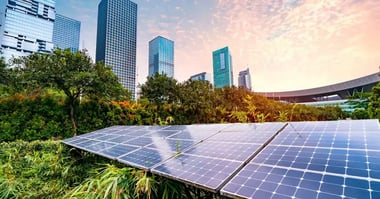
Beth Howell
Beth has been writing about the environment and climate change for over four years now – with her work being featured in publications such as The BBC, Forbes, The Express, Greenpeace, and in multiple academic journals.
The rise of the conscious consumer is well and truly set in motion. In fact, shoppers across all generations are now willing to spend more money on sustainable products, according to Forbes.
Another key consumer trend blooming in the 21st century is online retail — also known as ecommerce. It’s estimated that around one in four purchases will take place on the internet by 2026.
These two trends go hand-in-hand. While online shopping isn’t always better for the environment, there are many ways a business can reduce its impact on the planet by switching to sustainable ecommerce. Read on to find out how to make this switch successful.
Alternatively, you can book a call with one of our in-house experts to see which areas of your business could cut back on waste and lend itself to a more circular economy. Once we’ve received your details, we’ll be in touch to create a bespoke plan.
What's on this page?
01 | What is sustainable ecommerce?02 | Benefits of using sustainable ecommerce for your business
03 | Best ways to make your ecommerce business more sustainable
04 | How does ecommerce impact the environment?
05 | Summary
FAQs
What is sustainable ecommerce?
The term ‘ecommerce’ refers to businesses buying and selling goods/services online — and ‘sustainable ecommerce’ is a way of doing this with a limited impact on the environment.
So what does a sustainable ecommerce business strategy look like? Typically, it involves online stores adopting environmentally and socially responsible practices, such as reducing packaging, utilizing renewable energy, and avoiding high shipping emissions.
Want to see how Shopify can make your ecommerce business greener? Check out our helpful guide: How to Make An Eco-Friendly Ecommerce Business With Shopify.
Is the term 'sustainable ecommerce' contradictory?
The term ‘sustainable’ can be a bit of a murky phrase, so let’s clear it up.
Environmental sustainability encourages people to live in a way that doesn’t put stress on natural resources. But does that mean the term ‘sustainable ecommerce’ is contradictory, given shopping encourages the consumption of materials?
That all depends on the individual business’s practices. Any brand that’s truly dedicated to sustainable ecommerce will outline transparent plans on how it aims to lower emissions, avoid unnecessary packaging, and generally reduce its impact on the planet.
That’s why it’s important for consumers to be aware of greenwashing — it can be fairly easy for businesses to claim to be sustainable, despite continuing with harmful practices.
Benefits of using sustainable ecommerce for your business
Sustainable ecommerce doesn’t just benefit the environment and conscious consumers — the company itself can benefit too.
Here are the top benefits of having sustainable ecommerce in a business strategy:
- Attracts more customers – More shoppers are choosing sustainability as a metric for whether or not they want to support a brand. In fact, there was a 71% increase in Google searches for sustainable goods between 2016 and 2021
- Reduces impact on the planet – By cutting back on plastic packaging, businesses can reduce the amount of fossil fuels they rely on, and the amount of natural resources they consume
- Saves money – Running factories and warehouses on renewable energy can be cheaper for businesses, especially if they switch to either solar or wind power. Similarly, using electric vehicles to deliver ecommerce goods can cut fuel costs
- Attracts more employees – 71% of employees and employment seekers say that environmentally sustainable companies are more attractive prospects, according to a survey by the IBM Institute for Business Value (IBV). And nearly half of people surveyed said they would accept a lower salary to work for these organizations
- Prepares businesses for the future – Fossil fuels are finite, which means businesses will have to make the switch to more sustainable practices in the near future. These changes have already started to happen too, with governments around the world announcing tighter laws on unsustainable business practices
- Can reduce tax – Some countries, such as the UK, offer tax incentives for any businesses that are switching to more sustainable processes
Best ways to make your ecommerce business more sustainable
Thinking of adopting sustainable ecommerce as part of your business strategy? Here are the best ways you can do it:
- Reduce unnecessary packaging
- Offset your impact
- Lower your transport emissions
- Empower your customers
- Remove recycling barriers
- Reducing returns
- Try “recommerce”
- Host your ecommerce site on a green platform
Want to find out more? Visit our page on How to Become a Sustainable Ecommerce Business for everything you need to know.

How does ecommerce impact the environment?
Although emissions fluctuate from business to business, we have a general idea of where ecommerce emissions come from, thanks to researchers at the Massachusetts Institute of Technology (MIT).
Packaging topped the list, representing almost half of the average online retailer’s carbon footprint. Product returns made up a quarter, with transport and property-related emissions filling the rest of the footprint.
And as consumption continues to increase — especially as events like Black Friday continue to gain popularity — so will these emissions. Not only will this further deplete our planet’s natural resources, but the rising amount of carbon emission pumped into the atmosphere will speed up climate change.
But if more brands adopt sustainable ecommerce as part of their business strategy, we can prevent climate change from worsening.
How do ecommerce emissions compare to in-person stores?
Various studies suggest that ecommerce businesses generally produce fewer emissions than in-person stores (also known as brick-and-mortar stores). The study carried out by MIT found ecommerce to be more sustainable than traditional retail in more than 75% of the scenarios developed in their base case.
Another study suggests that online shopping at large retailers in the US is 17% more carbon-efficient than visiting traditional stores.
Check out the charts below to compare how the average emissions generated from ecommerce and traditional stores are broken down.
Summary
There are countless factors that contribute to a company’s carbon footprint, and just as many ways to start chipping away at it.
Build sustainability into your company’s values, and it will ensure that every decision you make takes the planet into account – whether you’re sourcing raw materials, choosing a shipping partner, or deciding on packaging material.
Sustainable e-commerce isn’t always as obvious as recyclable packaging and electric vehicles. In some cases, it’s as subtle as detailed product descriptions or offsetting plastic use.
But if you’re investing time, money, and energy into the planet, you don’t have to be subtle. Consumers want to know which brands are sustainable, because they want to make a conscious choice.
Want to reduce your business’s plastic footprint? We can help. All you have to do is get in touch with our in-house team. Once we’ve received your details, we can arrange a call to discuss which plastic recovery plan will suit your business needs best.
FAQs
Why is ecommerce sustainability important?
The key reason why sustainable ecommerce is important is to limit our impact on the environment.
By utilizing more recycling materials, creating a more circular economy, and limiting carbon emissions whilst transporting products, sustainable ecommerce can help us continue our but
Sustainable ecommerce also increases brand loyalty amongst environmentally conscious customers, which can lead to more profits in the long term.
How can an online business be sustainable?
Retailers can introduce multiple sustainable practices into their production line and distribution services to reduce emissions. These can include using sustainable or recycled materials, introducing refill stations, powering offices and fleets with renewable energy, and partnering with green businesses.
What is the prediction for ecommerce in 2025?
Ecommerce sales are forecast to increase by at least 50% between 2022 and 2025 — from $907.9 billion to $1.4 trillion, according to dropshipping app Oberlo.
If we want to reduce the chance of climate change escalating, these ecommerce sales need to adopt sustainable practices.



.webp?width=380&name=Sustainable%20christmas%20(1).webp)
.webp?width=380&name=Plastic-on-the-beach%20(1).webp)
.webp?width=380&name=ESG-presentation%20(1).webp)

.webp?width=380&name=Buying-online%20(1).webp)


.webp?width=380&name=Sorting-trash%20(1).webp)
.webp?width=380&name=Sales%20(1).webp)
.webp?width=380&name=Ecommerce-business-owner%20(1).webp)
